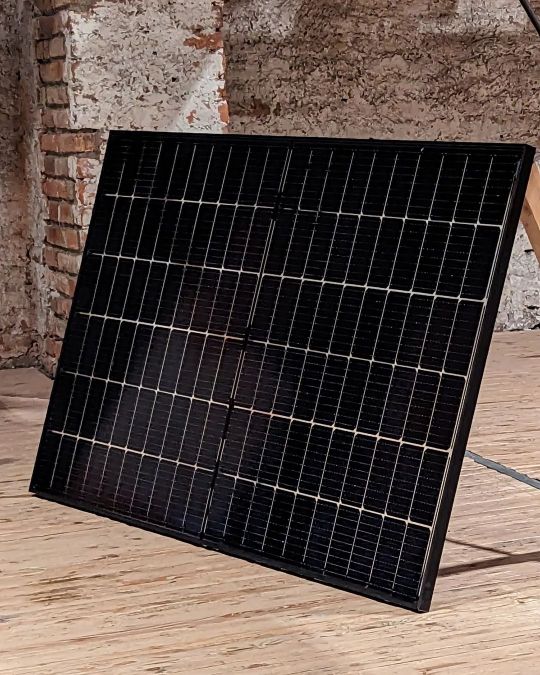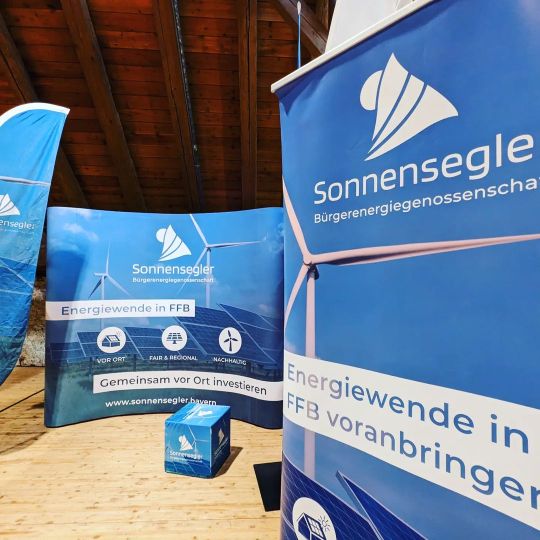#agripv
Explore tagged Tumblr posts
Photo

19 März Josefi Tag in Bayern Wünsche allen Namensvettern einen schönen Tag und wichtig die Energie dezentral Unterstützen ob als Hausbesitzer am Dach oder Mieter per Balkonsolar & im grossen Investieren mit Freifläche Photovoltaik / Windrad Empfehlung die Bürger Energiegenossenschaft Sonnensegler #ffb #solar #Energiewende #wareme #geothermie #windkraft #Photovoltaik #agripv #strom https://www.instagram.com/p/Cp-TOmJNjlJ/?igshid=NGJjMDIxMWI=
0 notes
Text
youtube
Check this 13 min movie on AgriPV from NCAT.
It's packed with great info.
link to their website for agriPV resources

0 notes
Text
Feedgy et Huasun dévoilent « le premier panneau solaire agrivoltaïque au monde »

L’entreprise française Feedgy, spécialisée dans l’optimisation des centrales photovoltaïque, a dévoilé un nouveau module solaire qui utilise une technologie photonique. Le HS-B96 AgriPV est le fruit d’une collaboration avec Huasun. ... Read the full article
0 notes
Text
AgriPV: Vattenfall investiert in 76 MW-Anlage
Bei Agri-Photovoltaik (AgriPV) wird ein und dieselbe landwirtschaftliche Fläche zur Nahrungsmittelproduktion und Erzeugung von Solarstrom genutzt. Durch dieses Verfahren können nutzbare Flächen erhalten, PV-Anlagen ausgebaut und somit Landwirtschaftsflächen effizienter genutzt werden. Vattenfall investiert nun in eine 76 Megawatt-Anlagen. (more…) “”

View On WordPress
0 notes
Text
0 notes
Text
0 notes
Text

The Future Prospects of Agrivoltaics in Modern Agriculture
What is Agrivoltaics?
Agrivoltaics, also known as agri solar panels, refers to the dual use of land for both agriculture and solar energy production. This innovative approach allows farmers to cultivate crops while generating renewable energy, optimizing land use and resources.
Benefits of Agrivoltaics
Agrivoltaics offers numerous benefits:
Increased Land Efficiency: Maximizes the utility of agricultural land by producing food and energy simultaneously.
Sustainable Energy Production: Reduces reliance on fossil fuels by harnessing solar power.
Improved Crop Yields: Creates microclimates that can protect crops from extreme weather and reduce water evaporation.
Research Directions
Ongoing research is crucial for enhancing the efficiency and effectiveness of agrivoltaic systems.
Researchers are exploring:
Optimizing Panel Placement: Studies are investigating the ideal positioning of panels to ensure maximum sunlight for both crops and solar cells.
Impact on Different Crops: Research is being conducted to understand how various crops respond to shade and light conditions created by solar panels.
Advanced Materials: Innovating new materials for solar panels that are more transparent, allowing more sunlight to reach the crops beneath.
Role in Food Security
Agrivoltaics has the potential to significantly contribute to global food security:
Adaptation to Climate Change: By creating more stable growing environments, agrivoltaics can help mitigate the adverse effects of climate change on agriculture.
Population Growth: With the global population projected to reach 9.7 billion by 2050, agrivoltaics offers a way to meet increasing food and energy demands without expanding agricultural land.
Real-World Examples
Several projects worldwide are showcasing the potential of agrivoltaics and agri solar panels:
France: The world’s largest dynamic agrivoltaic plant, featuring vineyards underneath solar panels, optimizes both wine production and energy generation.
Japan: Agrivoltaic systems are being used to grow crops such as lettuce and tomatoes, demonstrating significant improvements in crop yields and quality.
Challenges and Considerations
While promising, agrivoltaics also presents challenges:
Economic Viability: The initial investment for agrivoltaic systems can be high, requiring careful consideration of long-term benefits.
Technical Integration: Integrating solar panels with existing agricultural practices needs to be seamless to avoid disrupting farming activities.
Policy Support: Government policies and incentives play a crucial role in promoting the adoption of agrivoltaic systems.
Future Prospects
The future of agrivoltaics looks bright:
Technological Advancements: Continued innovation in solar technology and agricultural practices will enhance the efficiency of agrivoltaic systems.
Global Adoption: With increased awareness and support, more countries are likely to adopt agrivoltaics as a sustainable practice.
Collaborative Efforts: Partnerships between researchers, governments, and farmers will drive the successful implementation of agrivoltaics worldwide.
FAQs
What are agrivoltaics?
Agrivoltaics refers to the dual use of land for both agriculture and solar energy production, optimizing land use and resources.
How do agrivoltaics contribute to food security?
Agrivoltaics create more stable growing environments, helping to mitigate the adverse effects of climate change on agriculture and meeting the increasing food and energy demands.
What are the benefits of agrivoltaics?
Benefits include increased land efficiency, sustainable energy production, and improved crop yields due to optimized microclimates.
3rd Annual Agrivoltaics Europe Conference
The 3rd Annual Agrivoltaics Europe Conference by Leadvent Group is a key event for leaders, researchers, and policymakers focused on agrivoltaic technologies. It provides a platform to share insights, discuss challenges, and explore solutions in agrivoltaics. The conference aims to promote collaboration and advance sustainable agriculture and energy transition goals in Europe.
0 notes
Text

Optimizing Agrivoltaics for Different Crops to Boost Productivity and Sustainability
Understanding Agrivoltaic Systems
Agrivoltaics combines agricultural infrastructure with photovoltaic installations. By sharing the land, farmers can grow crops while harnessing solar energy, achieving dual productivity. The concept is simple but requires meticulous planning to optimize both plant growth and solar power generation.
Statistics Supporting Agrivoltaics
Agrivoltaics isn't just a theoretical idea; it's backed by promising statistics. For instance, a study found that agrivoltaic systems, also known as agripv, can increase crop yield by up to 60% due to the microclimate created by the shade from solar panels. Additionally, these agripv systems can reduce water usage by up to 20%, making them an attractive option for arid regions.
Optimal Panel Arrangements
Designing an agrivoltaic system starts with determining the optimal arrangement of solar panels. The goal is to balance sufficient sunlight for crops with maximum solar energy capture.
Vertical vs. Horizontal Panels
Vertical panels are often preferred for certain crops as they allow more light to penetrate between rows. This arrangement is ideal for low-growing crops like lettuce and spinach. Horizontal panels, on the other hand, can be beneficial for taller crops like corn and wheat, as they provide consistent shading and reduce heat stress.
Adjustable Panels
Some advanced agrivoltaic systems use adjustable panels that can be tilted or moved to optimize sunlight exposure throughout the day. This flexibility helps in adjusting to seasonal changes and different crop growth stages, ensuring maximum efficiency.
Shading Impacts and Crop Yield
Benefits of Shading
Moderate shading from solar panels can reduce the temperature around the crops, creating a microclimate that protects them from extreme heat. This can lead to higher yields, especially for crops sensitive to high temperatures.
Potential Drawbacks
While shading can benefit many crops, it may hinder the growth of those requiring full sunlight. Understanding the specific light requirements of different crops is crucial for designing effective agrivoltaic systems.
Case Study Example
Crops Benefiting from Agrivoltaics
Lettuce:
In Japan, agrivoltaic systems have boosted lettuce yield by 30%.
The microclimate created by the panels reduces water evaporation, enhancing growth.
Crops Facing Challenges
Sunflowers:
Require full sun and may not thrive under shaded conditions.
Adjustments in panel arrangements are necessary to ensure adequate sunlight.
FAQs on Agrivoltaic System
How does agrivoltaics impact water usage? Agrivoltaic systems can significantly reduce water usage by creating a cooler microclimate under the solar panels, reducing evaporation rates. Are there any crops that shouldn't be grown with agrivoltaics? Crops that require full, unobstructed sunlight, such as certain types of grains and sunflowers, may not be ideal candidates for agrivoltaic systems. What are the economic benefits for farmers? Farmers can benefit from dual income streams—revenue from crop sales and electricity generation. This diversification can provide financial stability and resilience against market fluctuations.
3rd Annual Agrivoltaics Europe For those interested in exploring agrivoltaic systems, attending events like the 3rd Annual Agrivoltaics Europe can provide valuable insights and networking opportunities with industry leaders. This event, held from November 5th to 7th, 2024, in Vienna, Austria, will feature case studies, strategic discussions, and the latest innovations in the field.
0 notes
Text

Introduction
The agricultural industry is rapidly transforming with technology, notably through agri solar panels. These innovations help farmers reduce carbon footprints while boosting crop yields and resource optimization. This post explores advancements in agri solar panels, AI and IoT's role in their optimization, and future trends.
Latest Advancements in Agri Solar Panels
Agri solar panels integrate photovoltaic systems into agriculture, maximizing solar energy while allowing light for crops. Bifacial panels enhance efficiency by capturing sunlight on both sides. Built for durability, they withstand harsh conditions like extreme temperatures and hail. Smart tracking systems further optimize solar energy capture by adjusting panel angles throughout the day using sensors and algorithms.
The Role of AI and IoT in Optimizing Agri Solar Panels
AI and IoT are transforming agri solar panel operations by enabling real-time monitoring and data analysis for efficient energy management. They facilitate predictive maintenance, anticipating issues before they become critical, and support data-driven decision-making by collecting and analyzing data on energy production and environmental conditions. Additionally, they enhance crop management by offering real-time insights into soil health, pests, and irrigation needs, helping farmers optimize yields and reduce waste.
Future Trends and Innovations to Watch
The future of agri solar panels is bright with innovations like integration with vertical farming, which enhances efficiency by providing sustainable energy. Floating solar panels reduce land use and improve energy efficiency when combined with agricultural water sources. Additionally, advanced energy storage solutions will ensure consistent power by storing excess solar energy for use during low sunlight periods.
3rd Annual Agrivoltaics Europe Forum
For those interested in learning more about the latest developments and trends in agrivoltaics, be sure to check out the 3rd Annual Agrivoltaics Europe Forum, taking place from November 5th to 7th, 2024, in Vienna, Austria. This event will feature industry leaders and experts discussing the future of agrivoltaics and its potential to revolutionize the agricultural industry. Visit Leadvent Group for more details and to register.
Frequently Asked Questions (FAQs)
1) What are agri solar panels?
Agri solar panels are photovoltaic systems integrated into agricultural settings to generate solar energy while allowing sufficient light to reach crops underneath. They help farmers reduce their carbon footprint and improve crop yields.
2) How do AI and IoT optimize agri solar panels?
AI and IoT technologies enable real-time monitoring and data analysis, leading to more efficient energy management. They provide predictive maintenance, data-driven decision-making, and enhanced crop management.
3) What are the future trends in agri solar panels?
Future trends include the integration of agri solar panels with vertical farming, the development of floating solar panels, and advanced energy storage solutions. These innovations aim to further enhance the efficiency and sustainability of agricultural practices.
0 notes
Photo

Werbung für die Energiewende Bürgersolar mit der Energiegenossenschaft Sonnensegler Aktiv Projekte Unterstützen im Landkreis FFB Heute noch auf der Messe Heim & Haus #solar #windkraft #agripv #Photovoltaik #sonnensegler https://www.instagram.com/p/Cp-PwfxNpVG/?igshid=NGJjMDIxMWI=
0 notes